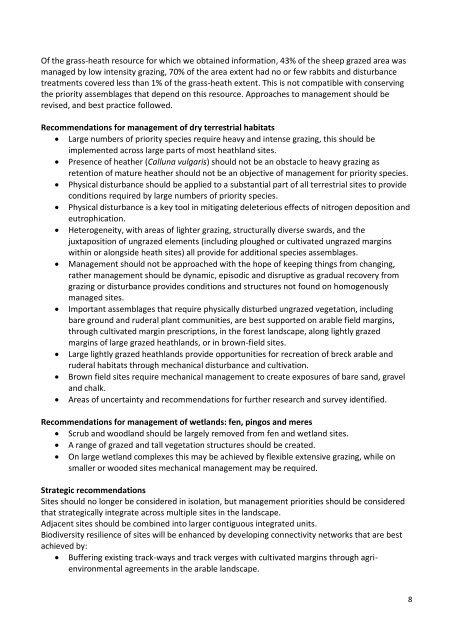Securing Biodiversity in Breckland - European Commission
Securing Biodiversity in Breckland - European Commission
Securing Biodiversity in Breckland - European Commission
Create successful ePaper yourself
Turn your PDF publications into a flip-book with our unique Google optimized e-Paper software.
Of the grass-heath resource for which we obta<strong>in</strong>ed <strong>in</strong>formation, 43% of the sheep grazed area wasmanaged by low <strong>in</strong>tensity graz<strong>in</strong>g, 70% of the area extent had no or few rabbits and disturbancetreatments covered less than 1% of the grass-heath extent. This is not compatible with conserv<strong>in</strong>gthe priority assemblages that depend on this resource. Approaches to management should berevised, and best practice followed.Recommendations for management of dry terrestrial habitats Large numbers of priority species require heavy and <strong>in</strong>tense graz<strong>in</strong>g, this should beimplemented across large parts of most heathland sites. Presence of heather (Calluna vulgaris) should not be an obstacle to heavy graz<strong>in</strong>g asretention of mature heather should not be an objective of management for priority species. Physical disturbance should be applied to a substantial part of all terrestrial sites to provideconditions required by large numbers of priority species. Physical disturbance is a key tool <strong>in</strong> mitigat<strong>in</strong>g deleterious effects of nitrogen deposition andeutrophication. Heterogeneity, with areas of lighter graz<strong>in</strong>g, structurally diverse swards, and thejuxtaposition of ungrazed elements (<strong>in</strong>clud<strong>in</strong>g ploughed or cultivated ungrazed marg<strong>in</strong>swith<strong>in</strong> or alongside heath sites) all provide for additional species assemblages. Management should not be approached with the hope of keep<strong>in</strong>g th<strong>in</strong>gs from chang<strong>in</strong>g,rather management should be dynamic, episodic and disruptive as gradual recovery fromgraz<strong>in</strong>g or disturbance provides conditions and structures not found on homogenouslymanaged sites. Important assemblages that require physically disturbed ungrazed vegetation, <strong>in</strong>clud<strong>in</strong>gbare ground and ruderal plant communities, are best supported on arable field marg<strong>in</strong>s,through cultivated marg<strong>in</strong> prescriptions, <strong>in</strong> the forest landscape, along lightly grazedmarg<strong>in</strong>s of large grazed heathlands, or <strong>in</strong> brown-field sites. Large lightly grazed heathlands provide opportunities for recreation of breck arable andruderal habitats through mechanical disturbance and cultivation. Brown field sites require mechanical management to create exposures of bare sand, graveland chalk. Areas of uncerta<strong>in</strong>ty and recommendations for further research and survey identified.Recommendations for management of wetlands: fen, p<strong>in</strong>gos and meres Scrub and woodland should be largely removed from fen and wetland sites. A range of grazed and tall vegetation structures should be created. On large wetland complexes this may be achieved by flexible extensive graz<strong>in</strong>g, while onsmaller or wooded sites mechanical management may be required.Strategic recommendationsSites should no longer be considered <strong>in</strong> isolation, but management priorities should be consideredthat strategically <strong>in</strong>tegrate across multiple sites <strong>in</strong> the landscape.Adjacent sites should be comb<strong>in</strong>ed <strong>in</strong>to larger contiguous <strong>in</strong>tegrated units.<strong>Biodiversity</strong> resilience of sites will be enhanced by develop<strong>in</strong>g connectivity networks that are bestachieved by: Buffer<strong>in</strong>g exist<strong>in</strong>g track-ways and track verges with cultivated marg<strong>in</strong>s through agrienvironmentalagreements <strong>in</strong> the arable landscape.8





